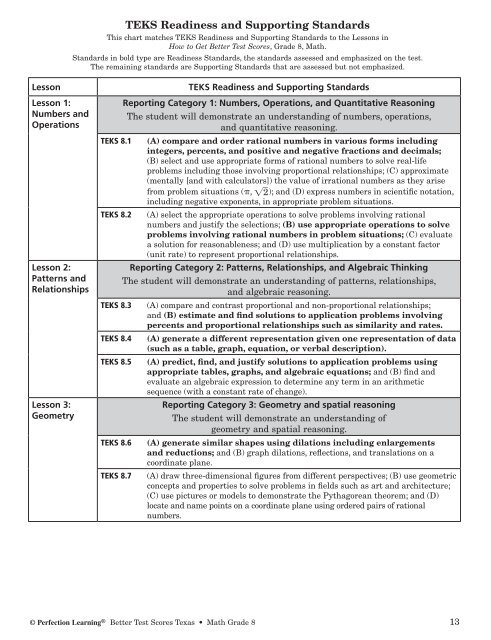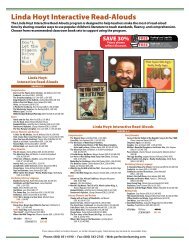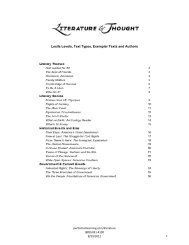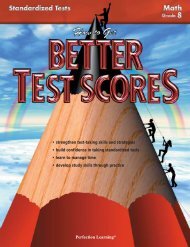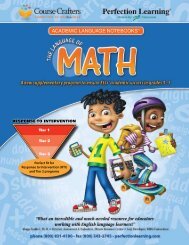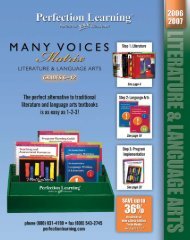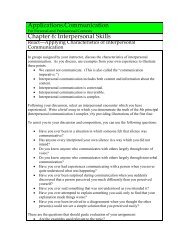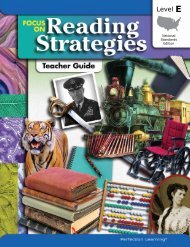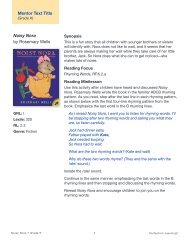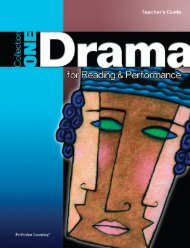TEKS Readiness and Supporting Standards - Perfection Learning
TEKS Readiness and Supporting Standards - Perfection Learning
TEKS Readiness and Supporting Standards - Perfection Learning
You also want an ePaper? Increase the reach of your titles
YUMPU automatically turns print PDFs into web optimized ePapers that Google loves.
<strong>TEKS</strong> <strong>Readiness</strong> <strong>and</strong> <strong>Supporting</strong> St<strong>and</strong>ardsThis chart matches <strong>TEKS</strong> <strong>Readiness</strong> <strong>and</strong> <strong>Supporting</strong> St<strong>and</strong>ards to the Lessons inHow to Get Better Test Scores, Grade 8, Math.St<strong>and</strong>ards in bold type are <strong>Readiness</strong> St<strong>and</strong>ards, the st<strong>and</strong>ards assessed <strong>and</strong> emphasized on the test.The remaining st<strong>and</strong>ards are <strong>Supporting</strong> St<strong>and</strong>ards that are assessed but not emphasized.LessonLesson 1:Numbers <strong>and</strong>OperationsLesson 2:Patterns <strong>and</strong>RelationshipsLesson 3:Geometry<strong>TEKS</strong> 8.1<strong>TEKS</strong> 8.2<strong>TEKS</strong> 8.3<strong>TEKS</strong> 8.4<strong>TEKS</strong> 8.5<strong>TEKS</strong> 8.6<strong>TEKS</strong> 8.7<strong>TEKS</strong> <strong>Readiness</strong> <strong>and</strong> <strong>Supporting</strong> St<strong>and</strong>ardsReporting Category 1: Numbers, Operations, <strong>and</strong> Quantitative ReasoningThe student will demonstrate an underst<strong>and</strong>ing of numbers, operations,<strong>and</strong> quantitative reasoning.(A) compare <strong>and</strong> order rational numbers in various forms includingintegers, percents, <strong>and</strong> positive <strong>and</strong> negative fractions <strong>and</strong> decimals;(B) select <strong>and</strong> use appropriate forms of rational numbers to solve real-lifeproblems including those involving proportional relationships; (C) approximate(mentally [<strong>and</strong> with calculators]) the value of irrational numbers as they arisefrom problem situations (p, =2); <strong>and</strong> (D) express numbers in scientific notation,including negative exponents, in appropriate problem situations.(A) select the appropriate operations to solve problems involving rationalnumbers <strong>and</strong> justify the selections; (B) use appropriate operations to solveproblems involving rational numbers in problem situations; (C) evaluatea solution for reasonableness; <strong>and</strong> (D) use multiplication by a constant factor(unit rate) to represent proportional relationships.Reporting Category 2: Patterns, Relationships, <strong>and</strong> Algebraic ThinkingThe student will demonstrate an underst<strong>and</strong>ing of patterns, relationships,<strong>and</strong> algebraic reasoning.(A) compare <strong>and</strong> contrast proportional <strong>and</strong> non-proportional relationships;<strong>and</strong> (B) estimate <strong>and</strong> find solutions to application problems involvingpercents <strong>and</strong> proportional relationships such as similarity <strong>and</strong> rates.(A) generate a different representation given one representation of data(such as a table, graph, equation, or verbal description).(A) predict, find, <strong>and</strong> justify solutions to application problems usingappropriate tables, graphs, <strong>and</strong> algebraic equations; <strong>and</strong> (B) find <strong>and</strong>evaluate an algebraic expression to determine any term in an arithmeticsequence (with a constant rate of change).Reporting Category 3: Geometry <strong>and</strong> spatial reasoningThe student will demonstrate an underst<strong>and</strong>ing ofgeometry <strong>and</strong> spatial reasoning.(A) generate similar shapes using dilations including enlargements<strong>and</strong> reductions; <strong>and</strong> (B) graph dilations, reflections, <strong>and</strong> translations on acoordinate plane.(A) draw three-dimensional figures from different perspectives; (B) use geometricconcepts <strong>and</strong> properties to solve problems in fields such as art <strong>and</strong> architecture;(C) use pictures or models to demonstrate the Pythagorean theorem; <strong>and</strong> (D)locate <strong>and</strong> name points on a coordinate plane using ordered pairs of rationalnumbers.© <strong>Perfection</strong> <strong>Learning</strong> ® Better Test Scores Texas • Math Grade 8 13
LessonLesson 4:MeasurementLesson 5:Probability &Statistics<strong>TEKS</strong> 8.8<strong>TEKS</strong> 8.9<strong>TEKS</strong> 8.10<strong>TEKS</strong> 8.11<strong>TEKS</strong> 8.12<strong>TEKS</strong> 8.13<strong>TEKS</strong> <strong>Readiness</strong> <strong>and</strong> <strong>Supporting</strong> St<strong>and</strong>ardsReporting Category 4: MeasurementThe student will demonstrate an underst<strong>and</strong>ing of the concepts<strong>and</strong> uses of measurement.(A) find lateral <strong>and</strong> total surface area of prisms, pyramids, <strong>and</strong> cylindersusing [concrete] models <strong>and</strong> nets (two-dimensional models); <strong>and</strong> (C) estimateanswers <strong>and</strong> use formulas to solve application problems involvinglateral <strong>and</strong> total surface area <strong>and</strong> volume.(A) use the Pythagorean theorem to solve real-life problems; <strong>and</strong> (B) useproportional relationships in similar two-dimensional figures or similarthree-dimensional figures to find missing measurements.(A) describe the resulting effects on perimeter <strong>and</strong> area when dimensions ofa shape are changed proportionally; <strong>and</strong> (B) describe the resulting effect onvolume when dimensions of a solid are changed proportionally.Reporting Category 5: Probability <strong>and</strong> StatisticsThe student will demonstrate an underst<strong>and</strong>ingof probability <strong>and</strong> statistics.(A) find the probabilities of dependent <strong>and</strong> independent events; <strong>and</strong> (B)use theoretical probabilities <strong>and</strong> experimental results to make predictions <strong>and</strong>decisions.(A) select the appropriate measure of central tendency or range to describe a setof data <strong>and</strong> justify the choice for a particular situation; (B) draw conclusions <strong>and</strong>make predictions by analyzing trends in scatterplots; <strong>and</strong> (C) select <strong>and</strong> use anappropriate representation for presenting <strong>and</strong> displaying relationships amongcollected data, including line plots, line graphs, [stem <strong>and</strong> leaf plots,] circlegraphs, bar graphs, box <strong>and</strong> whisker plots, histograms, <strong>and</strong> Venn Diagrams [with<strong>and</strong>] without the use of technology.(A) evaluate methods of sampling to determine validity of an inferencemade from a set of data; <strong>and</strong> (B) recognize misuses of graphical ornumerical information <strong>and</strong> evaluate predictions <strong>and</strong> conclusions basedon data analysis.14 © <strong>Perfection</strong> <strong>Learning</strong> ® Better Test Scores Texas • Math Grade 8
LessonLesson 6:ProblemSolving<strong>TEKS</strong> <strong>Readiness</strong> <strong>and</strong> <strong>Supporting</strong> St<strong>and</strong>ardsUnderlying Processes <strong>and</strong> Mathematical ToolsThese skills will not be listed under a separate recording category. Instead, they willbe incorporated into at least 75% of the test questions in reporting categories 1–5<strong>and</strong> will be identified along with content st<strong>and</strong>ards.<strong>TEKS</strong> (8.14) (A) identify <strong>and</strong> apply mathematics to everyday experiences, to activities in<strong>and</strong> outside of school, with other disciplines, <strong>and</strong> with other mathematicaltopics; (B) use a problem-solving model that incorporates underst<strong>and</strong>ing theproblem, making a plan, carrying out the plan, <strong>and</strong> evaluating the solution forreasonableness; (C) select or develop an appropriate problem-solving strategyfrom a variety of different types, including drawing a picture, looking for apattern, systematic guessing <strong>and</strong> checking, acting it out, making a table, workinga simpler problem, or working backwards to solve a problem; <strong>and</strong> (D) select toolssuch as real objects, manipulatives, paper/pencil, <strong>and</strong> technology or techniquessuch as mental math, estimation, <strong>and</strong> number sense to solve problems.<strong>TEKS</strong> (8.15) (A) communicate mathematical ideas using language, efficient tools, appropriateunits, <strong>and</strong> graphical, numerical, physical, or algebraic mathematical models.<strong>TEKS</strong> (8.16) (A) make conjectures from patterns or sets of examples <strong>and</strong> nonexamples; <strong>and</strong>(B) validate his/her conclusions using mathematical properties <strong>and</strong> relationships.© <strong>Perfection</strong> <strong>Learning</strong> ® Better Test Scores Texas • Math Grade 8 15


